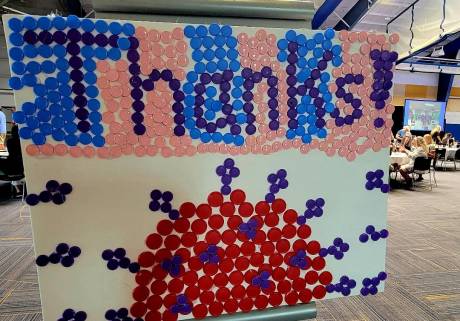Goose flies high with activity

Oakfield’s landscape just got more colorful, thanks to a mural painted on the outside of The Goose Community Center at 33 South Main St.
Painted by artist David Burke and Oakfield-Alabama High School alumni Megan and Stephanie Gilman, the open-air agricultural scene is just half the story of the building, co-owner Susan Zeliff says. Inside houses a food pantry, local group meetings, seasonal clothing, stamping classes, and a vision for the future.
“Our big picture for our building is to have a community room available … for private gatherings (birthday parties, wedding showers, etc.) as well as community meals, anything that will bring the community together,” Zeliff said to The Batavian this week. “We are planning on having a commercial kitchen and have had people in the community already ask about being able to use it for their canning or baking.”
Other projects on the horizon include a farm market to provide people with easier access to fresh foods, she said, and space for the many bakers and artisans in the community.
“We would love to provide them with a place to sell their creations,” Zeliff said. “We really want our community center to be for the community and to have as many community hands touch it as possible.”
Ever heard of the Goose? It has been a best-kept secret that has more recently been the topic of attention since the mural’s green pasture, farmland, and friendly cows showed up later this summer. The pantry actually began three years ago in a small section of Oakfield-Alabama school. It was moved to the South Main Street site in November 2020. Formerly a Yellow Goose more than a decade ago, the defunct building was dubbed as an acronym for God’s On Our Side Every day. The GOOSE program was an addition to Warrior House of Western New York, a nonprofit founded in 2015 by Zeliff and her husband Peter Zeliff Jr.
Godly Warriors
Warrior House began as a way for the Zeliff couple to bring veterans together a few weekends a year to hunt on some of the couple’s farmland.
“When we became aware of the need for food in our community we decided to add this program to our already existing nonprofit,” Mrs. Zeliff said. “Our mission for the Warrior House started with veterans, who will always hold a special place in our hearts, but the reality of life is that many people in our community are in need of the camaraderie that we offer to our veterans.
The hunting events not only brought veterans together, she said, but also volunteers to provide the meals and guides to lead the hunts. Central to it all has been a sense of camaraderie, empathy, and healing around food, whether it’s a quick breakfast or lingering dinner.
Some people may not understand what it is like to not be able to put food on the table or struggle to provide basic needs for one’s family, Mrs. Zeliff said.
Tending to Need
“This is where the food pantry plays out,” she said. “If we were not dealing with Covid I would challenge everyone to spend time in their child’s school. You will truly see the cracks in your community if you do. Children will tell you stories that will bring you to your knees and leave you holding back tears and not being able to sleep at night.”
Just as she envisions the big picture for the Goose, Mrs. Zeliff, of Oakfield, opens her eyes wide for her community. This project is about more than treating a symptom. It catches the residual “trickle-down effect” as well, she said.
“When your straight-A school-loving student sits in class with a child who has problems at home and brings them to school, that is directly impacting your family,” she said. “This is not just an Oakfield thing; this is a life thing happening everywhere.”
The Zeliffs are honored to be able to do what they can, even when it seems to be the simplest of tasks: providing children and families with food to alleviate their current circumstances of having a hungry child, she said. The husband and wife team once each owned a business in Oakfield and have enjoyed the area, she said.
When the dreadful Covid pandemic hit, the couple made another investment after the school pantry had to be moved out. Purchasing the Goose building was “an opportunity to serve more families in the community with their food needs,” Mrs. Zeliff said, crediting fellow helpers Katie Zimmerman, Bridget Campbell, Kendra Lamb, Candace George, Melissa Domoy, and Elementary School Principal Lynn Gehlert for establishing the new pantry location. A community garden, developed on land provided by Bonduelle and run by Audra Delpriore and a garden committee, contributes fresh vegetables and fruits. Foodlink is the consistent supplier of food for the pantry and community members, churches and businesses have been steadfast donors to the cause.
Inside Out
It seemed only natural to bring some of that generous allegiance outdoors with a piece of artwork for public view. Through a conversation with Tammy Hathaway of United Way, Mrs. Zeliff was directed to GO ART! for assistance with the project. The organization referred her to artists, including David Burke.
Burke has been painting since he was a youngster, and his mural works can be seen in Bergen, Tonawanda, and Batavia. His artwork is to be featured in a show of paintings at GO ART! in Batavia this September.
Fellow artists Stephanie Gilman, an Oakfield-Alabama 2016 graduate, and Megan Gilman, a 2019 graduate, assisted Burke with the creation. The Gilmans have also created art for the Oak Grill Car Show T-shirts, the Town flag, and a design for Kenmore Mercy Hospital’s Quiet Hours signage.
The list goes on with other pantry helpers Oakfield-Alabama National Honor Society, Student Council, and other high schoolers that have painted, planted flowers, and/or worked at the pantry. Some 20 volunteers assist with pantry chores, organize clothing donations or hand out books to families.
And the Zeliffs are grateful for each one of them.
“It truly takes a lot of hands to make it all run smoothly and we are very blessed to have these hands,” Mrs. Zeliff said. “It is important to us that our youth see the importance of caring for others in the community you live in. They may grow up and move on to bigger or maybe even smaller communities, and we hope that what we are doing with this building will make them want to be an active part of any community they live in. We want them to be the branch of an Oak tree where ever they go. They are our future.”
Since opening the doors at 6 p.m. on Veteran’s Day last year, the Goose has served more than 100 families. The building interior is not exactly beautiful, she said, but “we are doing beautiful things within its walls.” There have been lessons along the way, from the beauty of how conversations can open up new opportunities to how everyone is born with some type of gift, she said, and many people have generously offered what they have. She also added timing to a lesson learned.
“God totally has the steering wheel on this whole thing we are doing,” she said. “I am not typically a patient person, and this whole project has been slow, but it has been very steady and I can take no credit to that. I believe it is all God and it is definitely happening on his timeline.”
The pantry is open from 9 to 10 a.m. and 6 to 7 p.m. on the second and fourth Wednesdays of each month. Clothing and footwear are collected and distributed on a seasonal basis, from spring and summer items and back-to-school wear to winter coats and boots.
This project was made possible with funds from the Decentralization Program, a regrant program of the New York State Council on the Arts with the support of Governor Andrew Cuomo and the New York State Legislature and administered by GO ART!
Top photo by Arielle McVay. Photos below by Jim Burns.




















